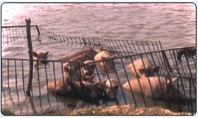Fish cum Piggery
- The pig dung as an organic manure for fish culture has certain advantages over cattle manure.
- The waste produced by 20-30 pigs is equivalent to one ton of Ammonium sulphate applied to the soil.
- The pigs are fed largely on kitchen waste, aquatic plants and crop byproducts.
- At present, fish-pig integration is practiced in all the developing countries.
- Several exotic breeds of pigs have been introduced in the country to augment pork production.
- The popular races are the white Yorkshire, Berkshire and Landrace.
- The pigsties should provide adequate protection from adverse weather conditions. A run or courtyard adjacent to the pig house is essential.
|
 |
- The size of the pig house depends on the number of pigs to be reared.
- Floor space is provided @ 3-4 m2 for every pig weighing 70-90 kg. The pigsties are built mostly at the pond sites and even over the ponds.
- The washings from the pigsties containing dung and urine are either channelized directly into the pond or composed before its application.
- The boars, sows and finishing stocks are housed separately.
- Maize, groundnut, wheat- bran, fishmeal, mineral mixture provide base for concentrated feed mixture. In advanced countries, garbage is widely used to economize pork production and provided after pre-cooking when pig dung is applied to a pond.
- It enhances the biological productivity of the pond.
- A portion of dung is directly consumed by some fish also. The excreta voided by 35-40 pigs are found adequate to fertilize one hectare of water. Integrated fish-pig farming is a viable and feasible scientific approach to augment fish production at low cost.
- The net income in this integration from one hectare of pond is Rs.2,60,000/-.
|
Updated on : March 2015 |

